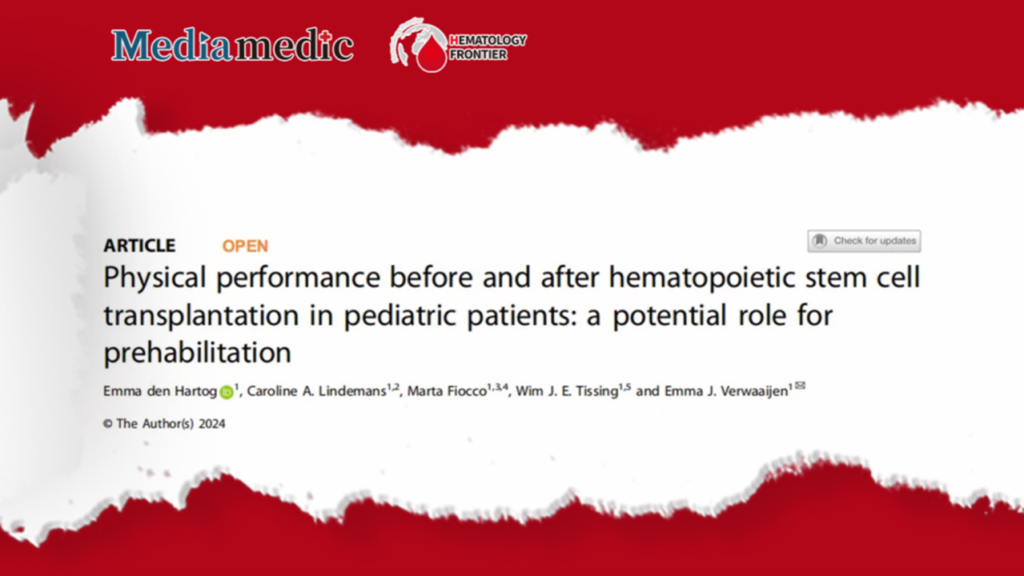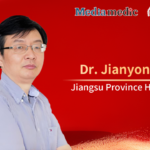
The "News Express" column aims to bridge the gap between cutting-edge research and clinical practice, allowing every hematology enthusiast and professional to quickly capture industry trends, spark innovative thinking, and broaden professional horizons. Hematology Frontier carefully selects the latest hematology research findings from top global journals, delivering every brilliant spark of science and clinical practice to you. We invite you to follow this column and join global hematology experts on the journey of scientific exploration!Literature Review
Hematopoietic stem cell transplantation (HSCT) often leads to disability-related complications that can impact the physical function of pediatric patients. However, knowledge is limited regarding the timing of physical performance impairments and the factors contributing to these impairments. This study conducted a retrospective analysis of the physical function of children aged 3 to 18 years, 100 days after HSCT, aiming to elucidate the relationship between pre- and post-HSCT physical performance and to uncover the impact of HSCT on physical function. The results revealed that compared to average values for healthy populations, children had lower hip flexor strength, reduced appendicular skeletal muscle mass, and slower times rising from the floor 100 days post-HSCT. Pre-HSCT physical performance was positively correlated with post-HSCT physical performance, independent of age, cumulative glucocorticoid dosage, and total hospitalization time during HSCT. This exploratory study highlights the potential role of prehabilitation in improving physical function in pediatric HSCT patients.
Exploring Physical Function Impairments and Intervention Strategies in Pediatric HSCT Patients
Allogeneic HSCT is a curative treatment for children with bone marrow dysfunction due to (relapsed) malignancies or hematologic diseases. HSCT allows for higher doses of chemotherapy, which is crucial for replacing damaged stem cells with healthy ones and forming a new immune system to recognize and kill disease cells. Improvements in HSCT and supportive care have increased post-transplant survival rates, with a current 5-year survival rate of approximately 80% for pediatric HSCT recipients. However, the HSCT process is complex and often accompanied by debilitating complications that can affect patients’ quality of life and rehabilitation process.
Pediatric HSCT patients require intensive conditioning regimens, including high-dose myeloablative chemotherapy and total body irradiation, to reduce tumor burden and suppress the immune system. Graft-versus-host disease (GvHD) is a serious complication of HSCT, affecting about one-third of pediatric patients. These factors increase the risk of physical function decline, as they can cause systemic symptoms such as nausea, fatigue, and pain, limiting activity. The direct toxic effects of high-dose treatments, the use of glucocorticoids associated with treatment, and the nutritional decline commonly accompanying GvHD can lead to muscle atrophy and catabolic processes, further impairing physical function. Moreover, patients must undergo at least six weeks of protective isolation from the start of rehabilitation to reduce the risk of life-threatening infections. This prolonged isolation can restrict movement, reduce physical activity, and potentially have negative effects on the body.
Previous studies have revealed differences in the degree of physical function impairment between pediatric and adult HSCT recipients. Early post-HSCT, the incidence of physical function impairment ranges from 10% to 17%, as reported by patients or physicians. This trend persists, with 40% to 62% of pediatric HSCT survivors showing limited mobility 1 to 16 years later. Such impairments significantly impact long-term functional independence, participation in daily activities, and overall quality of life. In adult patients, limitations in muscle strength, physical function, and mobility have been documented shortly after HSCT and even decades later. However, there is a significant knowledge gap regarding the physical function of pediatric HSCT patients in the months following the procedure and the associated risk factors.
The research team hypothesized that children undergoing HSCT might already have physical function impairments due to previous treatments, increasing their risk of further functional decline during HSCT. In previous studies, a specific pattern was observed in children with acute lymphoblastic leukemia (ALL): lower muscle mass and strength before a five-day course of dexamethasone treatment increased the risk of subsequent physical frailty. If similar circumstances exist pre- and post-HSCT, it suggests that rehabilitation strategies could be beneficial. In adults, prehabilitation measures have shown positive effects on physical function, reducing fatigue and improving quality of life within three months after transplantation. However, related studies in pediatric patients have not yet been conducted. Therefore, this study evaluated the physical function of pediatric patients 100 days after HSCT and clarified the relationship between pre- and post-HSCT physical performance, while also revealing the impact of intensive treatments during HSCT, including high-dose glucocorticoid use and prolonged isolation hospitalization, on post-transplant physical performance.
Physical Therapy Assessment for Quantifying Physical Function
In this retrospective cohort study, 77 patients aged 3 to 18 years who underwent allogeneic HSCT at Princess Máxima Center for Pediatric Oncology between December 2018 and August 2022 were included, excluding those with congenital developmental disorders or syndromes affecting physical function. Eligible patients underwent an inpatient assessment approximately 100 days before and after transplantation, including at least one physical therapy assessment of physical function. For patients who underwent multiple transplants during the study period, only data from the most recent transplant were analyzed.
During physical therapy assessments, individualized evaluation plans were tailored to patients’ specific health conditions and abilities, covering aspects such as muscle strength, muscle mass, and physical function. Muscle strength was measured using the MicroFET2 handheld dynamometer (HHD). For each leg, three isometric strength tests were performed for hip flexion, knee extension, and ankle dorsiflexion, recording the highest value for each test and taking the average of the highest values from both legs as the final result. Grip strength was measured using the Jamar HHD device, with the patient seated and the elbow flexed at 90 degrees. Three tests were performed for both the dominant and non-dominant hands, and the highest score for each was recorded. Muscle mass was estimated using the Tanita MC-780 bioelectrical impedance analyzer (BIA) to measure appendicular skeletal muscle mass (ASMM), the sum of muscle mass in the arms and legs. Physical function was assessed through three physical tests: the time to rise from the floor (TRF), the 10-meter walk test (10-MWT), and the timed up-and-down stairs (TUDS) test. In these tests, higher scores indicate longer times to complete the actions, indicating poorer physical function.
Prehabilitation as a Key Strategy for Enhancing Physical Function in Pediatric HSCT Patients
This exploratory study revealed a correlation between pre-HSCT physical status and post-HSCT physical performance within 100 days. Notably, this correlation was independent of factors such as age, cumulative glucocorticoid dosage, and total hospitalization time during HSCT. The pre-HSCT physical condition is crucial for mitigating functional decline and promoting postoperative recovery, aligning with the principle of “better in, better out.” A randomized controlled trial showed that exercise and range-of-motion training before abdominal surgery led to better physical performance, such as improved walking speed and stair-climbing ability, compared to interventions implemented only after surgery. In adult transplant recipients, prehabilitation measures, including exercise interventions, have been proven to improve physical function, reduce fatigue, and enhance quality of life within three months post-transplant.
In summary, this study emphasizes the importance of physical fitness assessment before HSCT and highlights the potential value of prehabilitation in enhancing physical function in pediatric HSCT patients.


